
Royal Botanic Gardens, Kew is a non-departmental public body in the United Kingdom sponsored by the Department for Environment, Food and Rural Affairs. An internationally important botanical research and education institution, it employs 1,100 staff. Its board of trustees is chaired by Dame Amelia Fawcett.

Bignoniaceae is a family of flowering plants in the order Lamiales commonly known as the bignonias or trumpet vines. It is not known to which of the other families in the order it is most closely related.

Violaceae is a family of flowering plants established in 1802, consisting of about 1000 species in about 25 genera. It takes its name from the genus Viola, the violets and pansies.

Sir William Jackson Hooker was an English botanist and botanical illustrator, who became the first director of Kew when in 1841 it was recommended to be placed under state ownership as a botanic garden. At Kew he founded the Herbarium and enlarged the gardens and arboretum. The standard author abbreviation Hook. is used to indicate this person as the author when citing a botanical name.
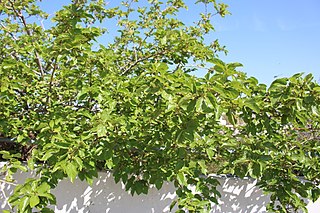
Morus alba, known as white mulberry, common mulberry and silkworm mulberry, is a fast-growing, small to medium-sized mulberry tree which grows to 10–20 m (33–66 ft) tall. It is generally a short-lived tree with a lifespan comparable to that of humans, although there are some specimens known to be more than 250 years old. The species is native to China and India and is widely cultivated and naturalized elsewhere.

Richard Spruce was an English botanist specializing in bryology. One of the great Victorian botanical explorers, Spruce spent 15 years exploring the Amazon from the Andes to its mouth, and was one of the first Europeans to visit many of the places where he collected specimens. Spruce discovered and named a number of new plant species, and corresponded with some of the leading botanists of the nineteenth century.
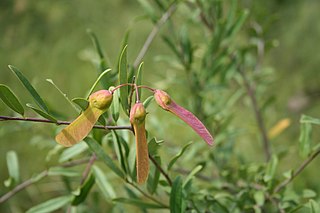
The Polygalaceae or the milkwort family are made up of flowering plants in the order Fabales. They have a near-cosmopolitan range, with about 27 genera and ca. 900 known species of herbs, shrubs and trees. Over half of the species are in one genus, Polygala, the milkworts.
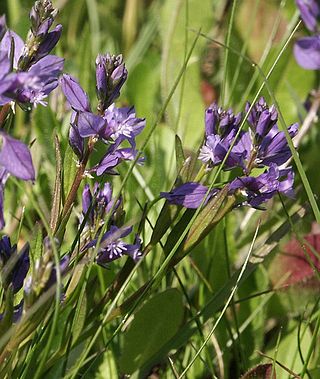
Polygala is a large genus of flowering plants belonging to the family Polygalaceae. They are commonly known as milkworts or snakeroots. The genus is distributed widely throughout much of the world in temperate zones and the tropics. The genus name Polygala comes from the ancient Greek "much milk", as the plant was thought to increase milk yields in cattle.

Peridiscaceae is a family of flowering plants in the order Saxifragales. Four genera comprise this family: Medusandra, Soyauxia, Peridiscus, and Whittonia., with a total of 12 known species. It has a disjunct distribution, with Peridiscus occurring in Venezuela and northern Brazil, Whittonia in Guyana, Medusandra in Cameroon, and Soyauxia in tropical West Africa. Whittonia is possibly extinct, being known from only one specimen collected below Kaieteur Falls in Guyana. In 2006, archeologists attempted to rediscover it, however, it proved unsuccessful.
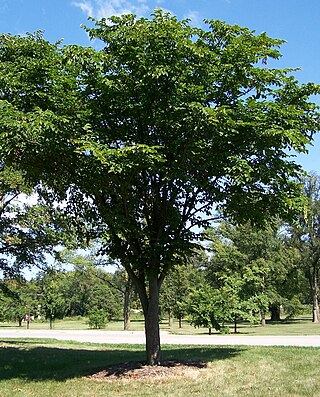
Ulmus laciniata var. nikkoensisRehder, the Nikko elm, was discovered as a seedling near Lake Chūzenji, near Nikkō, Japan, and obtained by the Arnold Arboretum in 1905. The taxonomy of the tree remains a matter of contention, and has been considered possibly a hybrid of U. laciniata and U. davidiana var. japonica. However, in crossability experiments at the Arnold Arboretum in the 1970s, U. laciniata, a protogynous species, was found to be incompatible with U. davidiana var. japonica, which is protandrous.

Neolitsea dealbata, also known as white bolly gum, hairy-leaved bolly gum, or simply bolly gum, is a shrub or small tree in the laurel family Lauraceae which is native to New South Wales and Queensland in Australia.
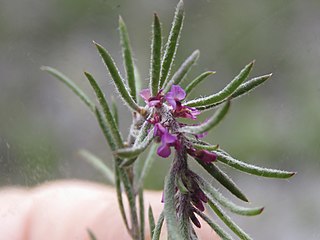
Muraltia is a genus of plants in the milkwort family (Polygalaceae) which is native to Southern and Eastern Africa. Most of the species are endemic to South Africa, and one species is naturalized in Australia. It is named after Johannes von Muralt, a Swiss botanist and surgeon.
Moutabea is a genus of flowering plants in the family Polygalaceae with 11 species. It was first described in 1775 by Jean Aublet. Most species are neotropical, ranging from Costa Rica to Bolivia and central Brazil, with one species, M. pacifica, native to New Caledonia.
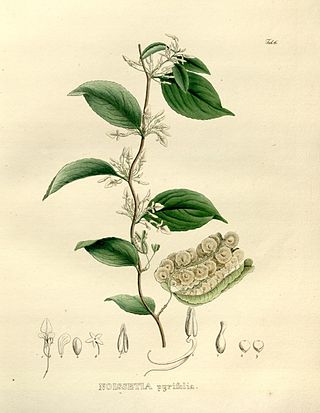
Anchietea is a genus of flowering plants in the violet family Violaceae, with six accepted species, found in tropical South America.
Carpolobia lutea is a plant species in the milkwort family (Polygalaceae). It is native to rainforests and the banks of streams with altitudes below 400 metres (1,300 ft) in coastal areas of West Africa. C. lutea was first formally named by George Don in 1831. According to the IUCN Red List, its population is stable and its conservation status is categorized as "least concern".

Carpolobia alba is a plant species in the milkwort family (Polygalaceae) that is endemic to rainforests, forest fringes, and savanna-park with altitudes below 400 metres (1,300 ft) in Western Tropical Africa. It is a shrub or small tree which is 3 to 6 metres tall. Its branches are puberulous or shortly pubescent. Its leaves are membranous or slightly leathery. The flowers it produces are yellowish white or white with a crimson spot at the base of upper petals. It produces yellow or scarlet-coloured fruit which are edible and usually contain 3 seeds. It was first described by George Don in 1831. It is used traditionally as a medicine against sexual dysfunction.
Atroxima afzeliana is a species of plant in the milkwort family (Polygalaceae). It is endemic to rainforests and forest fringes with altitudes below 200 metres (660 ft) in Western Tropical Africa. It was first described in 1868 by Daniel Oliver, at which point it was described as a new Carpolobia or a new genus. In 1905, Otto Stapf classified it into the atroxima genus.

Atroxima is a plant genus in the milkwort family (Polygalaceae). It is endemic to Western Tropical Africa. It was first described in 1905 by Otto Stapf in the Journal of the Linnean Society. It was initially in the Polygalaeae tribe before being split off with Carpolobia in 1992 to form the Carpolobieae tribe. They are lianas or liana-like shrubs which produce shiny, orange, fleshy uni- to tri-locular berries, these can have an area of up to 5 by 5 by 4 centimetres.

Xanthophyllum lanceatum is a tree in the Polygalaceae family. It grows across Southeast Asia from Sumatera to Bangladesh. The leaves are used as a hops-substitute in beer making and the wood as fuel. Fish in the Mekong regularly eat the fruit, flowers and leaves.















